Comba Telecom Network Systems RD-8132 RD8132 CDMA Repeater User Manual RD 8132 QI 1 0 0
Comba Telecom Ltd. RD8132 CDMA Repeater RD 8132 QI 1 0 0
PX8RD-8132 User Manual-Rev4

USER MANUAL FOR RD-8132
RD-8132 QI Copyright - refer to title page Page 1
ENU Status : 1-0-0
RD-8132
CDMA
REPEATER
USER MANUAL
The information contained herein is the
responsibility of and is approved by the
following, to whom all enquiries should
be directed in the first instance:
Comba Telecom Ltd
This is an unpublished work the copyright in which vests in Comba International ("Comba"). All rights reserved.
The information contained herein is confidential and the property of Comba and is supplied without liability for errors or
omissions. No part may be reproduced, disclosed or used except as authorised by contract or other written permission. The
copyright and the foregoing restriction on reproduction and use extend to all media in which the information may be embodied.
USER MANUAL FOR RD-8132
RD-8132 QI Copyright - refer to title page Page 2
ENU Status : 1-0-0
0.2 CONTENTS
Section Page
0.2 CONTENTS ...........................................................................................................................2
0.3 INDEX TO FIGURES .............................................................................................................3
0.4 ISSUE CONTROL..................................................................................................................3
0.5 SAFETY NOTICES AND ADMONISHMENTS ......................................................................5
1 EQUIPMENT DESCRIPTION................................................................................................6
1.1 BLOCK DIAGRAM .................................................................................................................6
1.2 EQUIPMENT CONSTITUTION .............................................................................................7
1.2.1 EQUIPMENT ENCLOSURE LAYOUT...................................................................................7
1.2.2 EQUIPMENT INTERNAL LAYOUT .......................................................................................7
2 INSTALLATION .....................................................................................................................9
2.1 INSTALLLATION CHECKLIST AND PREPARATION ..........................................................9
2.1.1 REPEATER INSTALLATION CHECKLIST............................................................................9
2.1.2 ANTENNA INSTALLATION CHECKLIST..............................................................................9
2.1.3 PREPARATIONS...................................................................................................................9
2.2 ELECTRICAL INSTALLATION ............................................................................................10
2.2.1 GROUNDING CONNECTION .............................................................................................11
2.2.2 POWER CONNECTION ......................................................................................................11
2.2.3 RF CABLE CONNECTION ..................................................................................................11
2.2.4 LI-ION BATTERY CONNECTION .......................................................................................11
2.2.5 OMT CONNECTION............................................................................................................12
2.2.6 EXTERNAL ALARM CONNECTION ...................................................................................12
2.2.7 DRIP-LOOP .........................................................................................................................12
2.2.8 REMOTE CONNETION OF OMT USING WIRELESS MODEM.........................................12
3 OMT .....................................................................................................................................14
3.1 LOCAL AND REMOTE CONNECTIONS TO OMT .............................................................14
3.1.1 LOCAL CONNECTION TO OMT.........................................................................................14
3.1.2 REMOTE CONNECTION TO OMT .....................................................................................15
3.2 OMT CONFIGURATION......................................................................................................15
3.3 RF PARAMETER.................................................................................................................16
3.3.1 SWITCH ...............................................................................................................................16
3.3.2 CHANNEL NO. ....................................................................................................................16
3.3.3 ATT ......................................................................................................................................17
3.3.4 ALARM THRESHOLD .........................................................................................................17
3.3.5 ALARM INFORMATION ......................................................................................................18
3.4 PROPERTIES INFO. ...........................................................................................................20
3.4.1 EQUIPMENT ID ...................................................................................................................20
3.4.2 COMM. CONFIG..................................................................................................................21
4 COMMISSIONING ...............................................................................................................22
4.1 PRE-COMMISSIONING TASKS .........................................................................................22
4.2 MCU LED INDICATOR AND RESET BUTTON ..................................................................22
4.3 COMMISSIONING PROCEDURE.......................................................................................23
5 TROUBLESHOOTING.........................................................................................................25
6 APPENDICES......................................................................................................................26
6.1 APPENDIX A: SERVICE POLICY AND RETURN OF EQUIPMENT..................................26
6.2 APPENDIX B: RMA (RETURN MATERIAL AUTHORIZATION) FORM .............................27
USER MANUAL FOR RD-8132
RD-8132 QI Copyright - refer to title page Page 3
ENU Status : 1-0-0
0.3 INDEX TO FIGURES
Figure 1: Block Diagram................................................................................................................................. 6
Figure 2: Equipment Enclosure Layout .......................................................................................................... 7
Figure 3: Equipment Internal Layout .............................................................................................................. 7
Figure 7: Equipment Connectors.................................................................................................................. 10
Figure 8: Equipment Connections................................................................................................................ 11
Figure 9: OMT Connection with Chassis Open............................................................................................ 12
Figure 10: Pins Allocation for EXT_ALM Connector .................................................................................... 12
Figure 11: Wireless Modem ......................................................................................................................... 13
Figure 12: Connection Type......................................................................................................................... 14
Figure 13: Serial Port Configuration............................................................................................................. 14
Figure 14: Remote Connection .................................................................................................................... 15
Figure 15: OMT Main Window...................................................................................................................... 15
Figure 16: Switch.......................................................................................................................................... 16
Figure 17: Channel No. ................................................................................................................................ 16
Figure 18: Frequency Calculator.................................................................................................................. 17
Figure 19: ATT.............................................................................................................................................. 17
Figure 20: Alarm Threshold.......................................................................................................................... 18
Figure 21: Master Alarm............................................................................................................................... 19
Figure 22: Channel Alarm ............................................................................................................................ 19
Figure 23: External Alarm............................................................................................................................. 20
Figure 24: Equipment ID .............................................................................................................................. 20
Figure 25: Com. Config. ............................................................................................................................... 21
Figure 26: MCU ............................................................................................................................................ 22
USER MANUAL FOR RD-8132
RD-8132 QI Copyright - refer to title page Page 4
ENU Status : 1-0-0
0.4 ISSUE CONTROL
Change No. ENU Details Of Change
1 1-0-0 First created and issued on 2008-09-24.
USER MANUAL FOR RD-8132
RD-8132 QI Copyright - refer to title page Page 5
ENU Status : 1-0-0
0.5 SAFETY NOTICES AND ADMONISHMENTS
This document contains safety notices in accordance with appropriate standards. In the interests of
conformity with the territory standards for the country concerned, the equivalent territorial admonishments
are also shown.
Any installation, adjustment, maintenance and repair of the equipment must only be carried out by trained,
authorised personnel. At all times, personnel must comply with any safety notices and instructions.
Specific hazards are indicated by symbol labels on or near the affected parts of the equipment. The labels
that conform to international standards are triangular in shape, and are coloured black on a yellow
background. An informative text label may accompany the symbol label.
Hazard labeling is supplemented by safety notices in the appropriate equipment manual. These notices
contain additional information on the nature of the hazard and may also specify precautions.
Warning Notices:
These draw the attention of personnel to hazards that may cause death or injury to the operator or others.
Examples of use are cases of high voltage, laser emission, toxic substances, point of high temperature,
etc.
Alert Notice:
These draw the attention of personnel to hazards that may cause damage to the equipment. An example
of use is the case of static electricity hazard.
Caution notices may also be used in the handbook to draw attention to matters that do not constitute a risk
of causing damage to the equipment but where there is a possibility of seriously impairing its performance,
e.g. by mishandling or gross maladjustment. Warnings and Cautions within the main text do not
incorporate labels and may be in shortened form.
Cautions:
The recommend use distance for external antenna is larger than 3.17 meter.
End of section
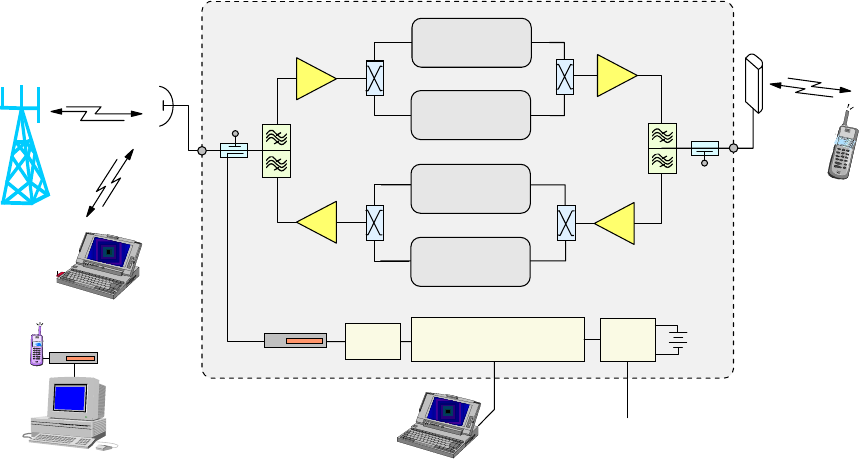
USER MANUAL FOR RD-8132
RD-8132 QI Copyright - refer to title page Page 6
ENU Status : 1-0-0
1 EQUIPMENT DESCRIPTION
The RD-8132 CDMA repeater is designed for CDMA850 networks. Band-specific linear MCPA and filtering
effectively amplifies the desired BTS carriers and provides superior out-of-band rejection. The unit can
incorporate two adjustable bandwidth segments. Remote configuration and surveillance is possible
through Comba’s remote control and monitoring system via PC or wireless modem to the OMT/OMC.
Internal Li-ion backup battery ensures alarm signals are sent out during power failure. The unit comes in a
sealed, cast aluminum enclosure, suitable for operation in all weather conditions.
This is an ideal product for outdoor coverage, especially for rural sides and mountain areas without signal
coverage. Site location shall be selected with care to avoid radiation effect to human being though this
product is meeting FCC regulation requirement. Any installation, adjustment, maintenance and repair of
the equipment must only be carried out by trained, licensed engineer.
1.1 BLOCK DIAGRAM
LNA1
LNA2
Mobile
Ant
Donor
Ant
Mobile
Power
Supply
Alarm
Indicator Main Control Unit
External
Power
OMT
Li-ion
BATT
Modem
DT MT
OMT
Computer with
Data card
Wireless
Modem
OMC
PA1
PA2
DL Band Selective
Module
DL Band Selective
Module
UL Band Selective
Module
UL Band Selective
Module
BTS
Figure 1: Block Diagram
In the downlink, the signal from the BTS is divided into RX/TX by duplexer in DT end and sent to LNA1,
then band selective module for selecting desired signals, followed by PA1 for amplifying the signal, and
then to duplexer in MT terminal; finally the signals are sent to the service antenna for signal coverage.
In the uplink, the mobile signals are received by the service antenna. Divided in RX/TX by the duplexer in
MT terminal and followed by LNA2, then band selective module for selecting desired signals, followed by
PA2 for amplifying. After the duplexer of DT end, the signals are sent to the donor antenna for
transmission back to the BTS.

USER MANUAL FOR RD-8132
RD-8132 QI Copyright - refer to title page Page 7
ENU Status : 1-0-0
1.2 EQUIPMENT CONSTITUTION
1.2.1 EQUIPMENT ENCLOSURE LAYOUT
Below is the enclosure layout:
295
450
600
Figure 2: Equipment Enclosure Layout
1.2.2 EQUIPMENT INTERNAL LAYOUT
This system typically consists of the following sub modules.
Figure 3: Equipment Internal Layout

USER MANUAL FOR RD-8132
RD-8132 QI Copyright - refer to title page Page 8
ENU Status : 1-0-0
No Identifier Functional Description
1 UL Frequency Selective
Module
2 DL Frequency Selective
Module
The frequency selective module is used to select desired signals and
filter unwanted signals effectively.
3 UL Power Amplifier (PA)
4 DL Power Amplifier (PA) PA fulfils power amplification function.
5
Integrated DPX (DT)
6
Integrated DPX (MT)
Integrated duplexer in DT end is integrated with Low Noise Amplifier
to pre-amplify the downlink signal and DL input power testing board to
test downlink input power; Integrated duplexer in MT end is integrated
with Low Noise Amplifier to pre-amplify the uplink signal and DL
VSWR testing borad to test DL VSWR & DL output power.
7 Main Control Unit(MCU)
The MCU is used to monitor and control the operation, it also provide
communication interfaces for remote control and suppervision. LED
indicators on the board provide operation status information.
8 Power Supply Unt (PSU) The PSU converts the input voltage into a stable DC power for
internal functional units and charge the Li-ion battery.
9 Li-ion Battery The Li-ion battery pack provides back-up power supply for internal
modems up to three hours in the event of main power failure.
10 Distribution Board
Each distribution board serves as a distributor for power and internal
communication within the equipment. On the distribution board
located the following connections: connection to function modules,
MCU, RS232 for local commissioning.
11 Surge Protector
The internal surge protectors are to provide protection to the PSU. On
the top of each surge protector is a little window, beneath which is a
coloured indicator. ‘Green’ indicates protection is available, and in the
event of a fault, the colour will turn to ‘Black’. When this occurs, the
surge protector has to be replaced.
When the equipment is DC powered, no surge protector is required.
12 Wirelss Modem
Wirelss modem is used for remote controlling and monitoring for
alarm transmission. It has connection for RF, data and power.There is
an indicator LED to show the modem status.
End of section

USER MANUAL FOR RD-8132
RD-8132 QI Copyright - refer to title page Page 9
ENU Status : 1-0-0
2 INSTALLATION
2.1 INSTALLLATION CHECKLIST AND PREPARATION
2.1.1 REPEATER INSTALLATION CHECKLIST
Installation Location Requirement Considerations
Power Supply
Provided power cord length is about 4m. Use a
dedicated AC breaker or fuse circuit with good access
to an earthing point. Here are the power supply
options for this repeater:
AC100~240V: 100V~240V/47Hz~63Hz
EMC and Interference Do not locate near large transformers or motors that
may cause electromagnetic interference.
Suitable operating environment -33 oC to +55 oC and maximum 95% relative humidity.
2.1.2 ANTENNA INSTALLATION CHECKLIST
Installation Location Requirement Considerations
Locate donor antenna in order to receive the
most appropriate signal level from the desired
BTS and to shield it from other signals at the
same time.
Field intensity of receiving site: Typical mobile phone
test field intensity ≥ -70dBm
Locate the service antenna directed away from
the donor cell.
Always try to maximize Isolation between
donor antenna and service antenna.
I > Gmax-13dB
The isolation must be 13 dB larger than the maximum
gain of the repeater in operation.
2.1.3 PREPARATIONS
z Open and check the content of the package received against the packing list. If any exernal
damages, please report to shipping agent. If any items are missing, contact Comba Telecom System.
z
Item Product Identifier Qty Remark
Mounting Rack R-9122C8-5140/1 1
Masonry Bolt M10x110 8
U Bolt M10x85x110 2
7-pin CPC connector X14J7P 1
Allen Key 5.5mm 1
Equipment Key N/A 2
Local Commissioning cable R-9122C/R-9122AC 1 Mark "9122"
Equipment Replacement Fuse T6.3AL250V 2
OMT Software and User
Manual OMT V3.22 or above 1
Equipment User Manual
On CD-
Rom This manual 1
z Prepare installation tools. The following are the recommended tools for new installation:
Tool Dimension
Electrically operated drill and masonry drill bits 12mm
Ring Spanner Assorted size: 12~30mm
Allen Key 5.5mm
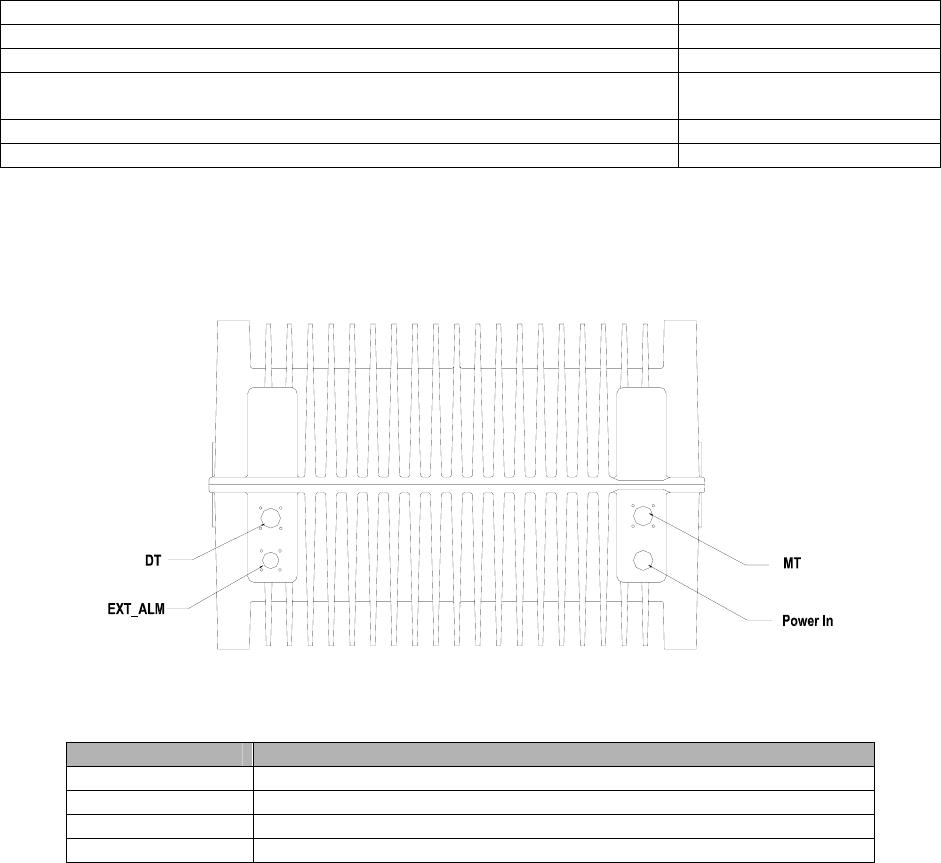
USER MANUAL FOR RD-8132
RD-8132 QI Copyright - refer to title page Page 10
ENU Status : 1-0-0
Knife for tape or cable stripping
Multi Meter to check cables, voltages alarms
PC with supplied OMT or OMC software
SIM cards both for repeater and modem with SMS (Short Message
Service) and CSD (Circuit Switch Data) enabled
External alarm cable for connction to external alarm terminals
Fused Power Outlet for repeater
2.2 ELECTRICAL INSTALLATION
The equipment has been designed for all cables entry from the bottom of the enclosure.
Figure 4: Equipment Connectors
Identifier Description
DT N-F connector for connection to donor antenna.
MT N-F connector for connection to service antenna.
EXT_ALM 7-pin CPC connector for external alarm input connection.
Power In A pre-installed power cord for connection to power supply.
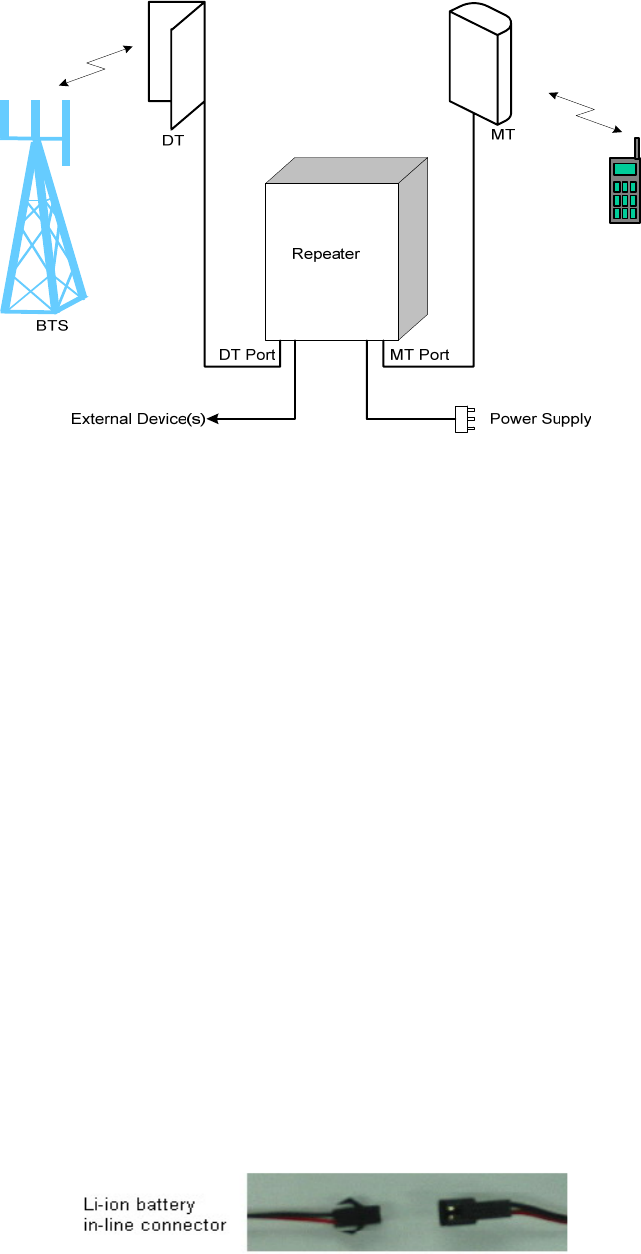
USER MANUAL FOR RD-8132
RD-8132 QI Copyright - refer to title page Page 11
ENU Status : 1-0-0
Here blow is the electrical installation application.
Figure 5: Equipment Connections
2.2.1 GROUNDING CONNECTION
The enclosure must be grounded securely by connecting a copper wire (CSA 16mm2) to the grounding
point on the mounting rack, and the other end to a protective ground (i.e. building earth point).
2.2.2 POWER CONNECTION
The system provides power supply options of AC220V/50Hz, AC110V/50Hz. The recommended AC
connection has three connections to include earth.
2.2.3 RF CABLE CONNECTION
Connection to donor antenna and mobile antenna is below:
z Donor antenna cable → DT port
z Mobile antenna cable → MT port
2.2.4 LI-ION BATTERY CONNECTION
The method to connect the Li-ion battery is product specific. For the Li-ion battery with switch, which
identified as “BAT2” on PSU, please enable the Li-ion battery by switching to “1” and disable by switching
to “0”. The Li-ion battery switch is OFF prior to shipment.
For the one without switch, an in-line connector close to the battery pack is used to control the Li-ion
battery connection, which is “disconnected” before shipping.
Notice: Please enable the Li-ion battery connection after equipment is powered to ensure alarm unit
working in the event of power failure.

USER MANUAL FOR RD-8132
RD-8132 QI Copyright - refer to title page Page 12
ENU Status : 1-0-0
2.2.5 OMT CONNECTION
With the chassis open, only use the local commissioning cable (R-9122C/R-9122AC) directly connects the
serial port of PC to the RS-232 port on the distribution board within the equipment.
Figure 6: OMT Connection with Chassis Open
2.2.6 EXTERNAL ALARM CONNECTION
Four external alarms INPUT are realized on the EXT_ALM port, this is a 7-pin CPC connector. Pin
numberings are shown looking-into the connector on the enclosure.
7
6
35
4
12
Figure 7: Pins Allocation for EXT_ALM Connector
Pin number 1 2 3 4 5 6 7
Alarm
definition
EXT.
Alarm 1
EXT.
Alarm 2
EXT.
Alarm 3 GND EXT.
Alarm 4 Reserved Reserved
These signals are defined as “TTL/CMOS level”, the following voltage are valid as EXT_ALM signals:
Voltage as applied to EXT Alarm Pin Alarm Condition recognizaed by system
Low Voltage: 0V to 1.5V Alarm recognized
High Voltage: 3.5V to 5V No Alarm recognized
2.2.7 DRIP-LOOP
Comba recommends that every horizontal cable entry to the equipment forms a 'U' before its entry to the
equipment. Any accumulated water on the cable will drip down at the bottom of the loop and will not climb
up to the equipment.
2.2.8 REMOTE CONNETION OF OMT USING WIRELESS MODEM
For the equipment equipped with wireless modem, the modem provides the option of remote connection of
the equipment to the OMT. The wireless modem implements the link for data and SMS.
RS-232
Distribution Board

USER MANUAL FOR RD-8132
RD-8132 QI Copyright - refer to title page Page 13
ENU Status : 1-0-0
Note: When CDMA modem is used, only SMS function is supported to retrieve alarm information and to
provide remote control.
The power and data cables have been factory-connected to the wireless modem. User needs to insert the
SIM / UIM card into the wireless modem.
To insert or replace the SIM / UIM card, locate and press down the recessed button (yellow) to eject the
SIM / UIM card carrier. Insert the SIM / UIM card and push back the carrier until it is latched in place.
Figure 8: Wireless Modem
The LED indicator on the wireless modem displays the state of the modem:
z LED OFF: equipment power off
z LED ON: equipment power on, no SIM/ UIM card or no connection to antenna
z LED flash slowly: equipment power on, in SMS mode
z LED flash quickly: equipment power on, in data link mode
Note: Data link mode is dependent on service availability from service provider. If it is required, the
operator’s SIM card must be data-enabled (Circuit Switch Data).
End of section
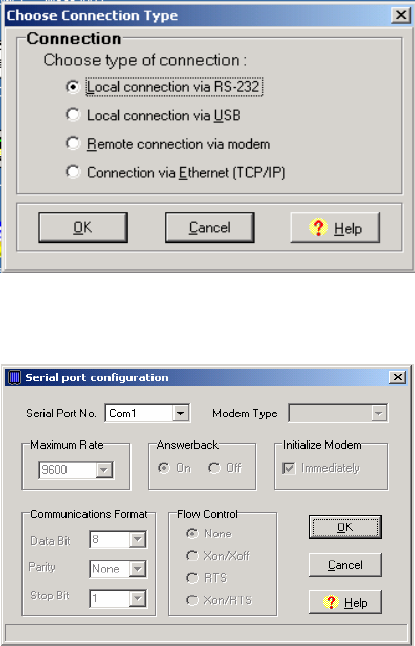
USER MANUAL FOR RD-8132
RD-8132 QI Copyright - refer to title page Page 14
ENU Status : 1-0-0
3 OMT
The equipment can be monitored and controlled by OMT software running on a local PC with local
commissioning cable, remote connection to the equipment via wireless GSM / CDMA network.
z OMT software running on a local PC with serial connection to the equipment.
z OMC (optional) software with remote connection to the equipment over wireless GSM / CDMA
network.
This chapter is to introduce how to apply local and remote connection to OMT for the first installation, for
the detailed OMT information, please refer to OMT user manual and other references.
Notice: The OMC software with remote connection to the equipment over wireless GSM / CDMA network
is optional for customers.
3.1 LOCAL AND REMOTE CONNECTIONS TO OMT
After installing OMT software on the PC, connection to the equipment can be done locally or remotely.
Double click the OMT exlorer icon, the OMT Explorer main screen window will appear.
3.1.1 LOCAL CONNECTION TO OMT
After databse configuration is done successfully, the following window will pop up and select [Local
connection via RS-232] for local connection.
Figure 9: Connection Type
Select the desired communication port and click “OK”, it will enter into the main window of OMT.
Figure 10: Serial Port Configuration
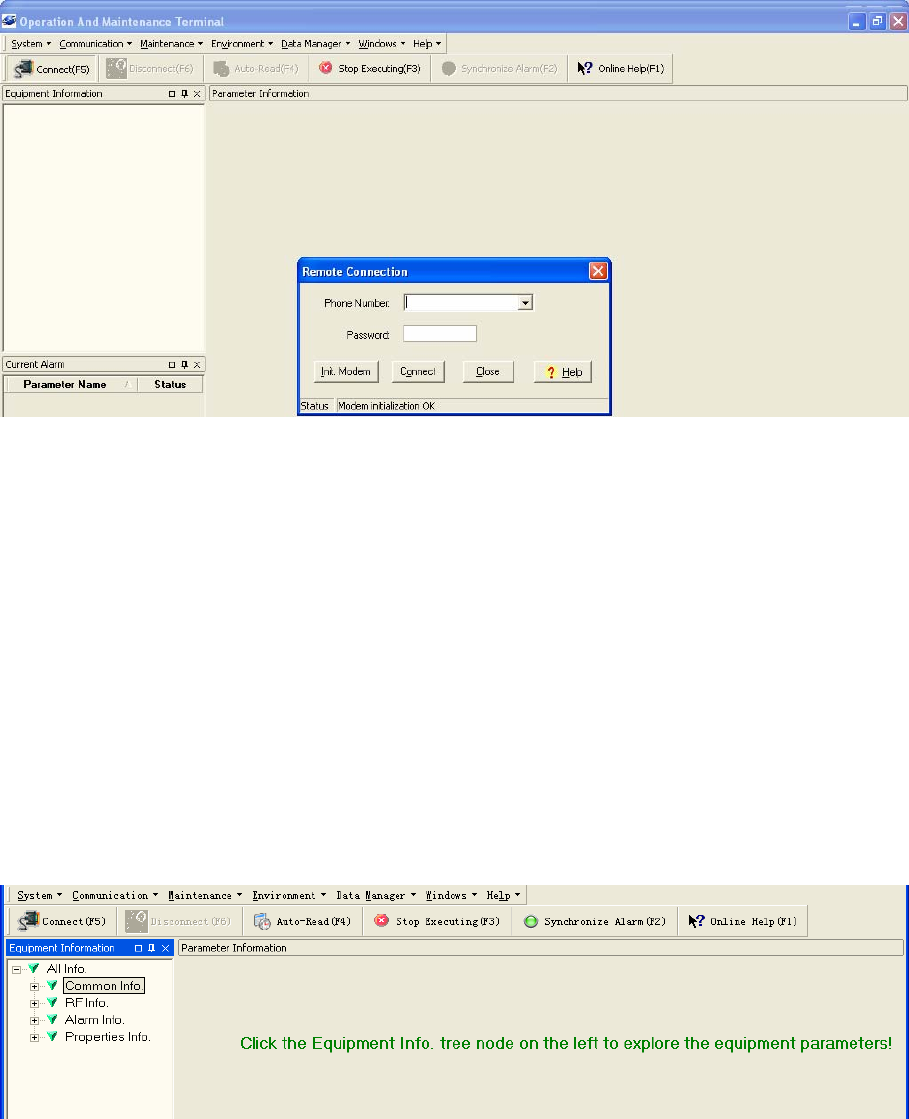
USER MANUAL FOR RD-8132
RD-8132 QI Copyright - refer to title page Page 15
ENU Status : 1-0-0
3.1.2 REMOTE CONNECTION TO OMT
If remote connection is needed, users can select [Remote connection via modem] in connection type
window. Select desired serial port and click “OK” in [Serial Port Configuration] window to go to OMT main
window and start modem initialization. Click “connect” and the [Remote Connection] window will show up.
Figure 11: Remote Connection
Config: Enter the correct phone number (Users don't have to enter the password) and click “connect”, it
will be connected remotely.
Notice: Please enable the SIM card to support Circuit Switch Data.
3.2 OMT CONFIGURATION
After entering the OMT main screen, click the “Connect” button on the toolbar, to connect the equipment
to the OMT. Successful connection will be indicated by a message “Online Ok” and equipment
parameters can be read and/or set.
Users can configure the parameters, and then offset the parameters according to desired coverage level
and interference to other BTS signals.
OMT parameters include: Common Information, RF Information, Alarm Information, and Properties
Information.
Figure 12: OMT Main Window

USER MANUAL FOR RD-8132
RD-8132 QI Copyright - refer to title page Page 16
ENU Status : 1-0-0
3.3 RF PARAMETER
It is recommended to configure the following RF parameters for the first installation.
3.3.1 SWITCH
Switch is to enable/disable power for carrier1,carrier2, RF and self-oscillation. When user checks and sets
non-RF parameters, such as checking physical antenna connection, switching off will disable equipment
power temporarily to protect PA in operation.
Figure 13: Switch
Config:
Select the required state in setting columns of RF information window for RF switch, then press [Enter] or
[Config] button to finish the configuration operation.
3.3.2 CHANNEL NO.
Channel No. includes Low Edge Channel No. and High Edge Channel No of working band 1/ 2. The value
in [MaxValue] column is the upper limit of the range, while the value in [MinValue] column is the lower limit
of the range.
The UL/DL Channel No.setting range: 1011~1023, 1~779
e.g. Working Band Low Edge Channel No. = 160(874.8MHz)
Working Band High Edge Channel No. = 611(888.33MHz)
Bandwidth=14.76MHz (inclosing 12 channals)
Figure 14: Channel No.
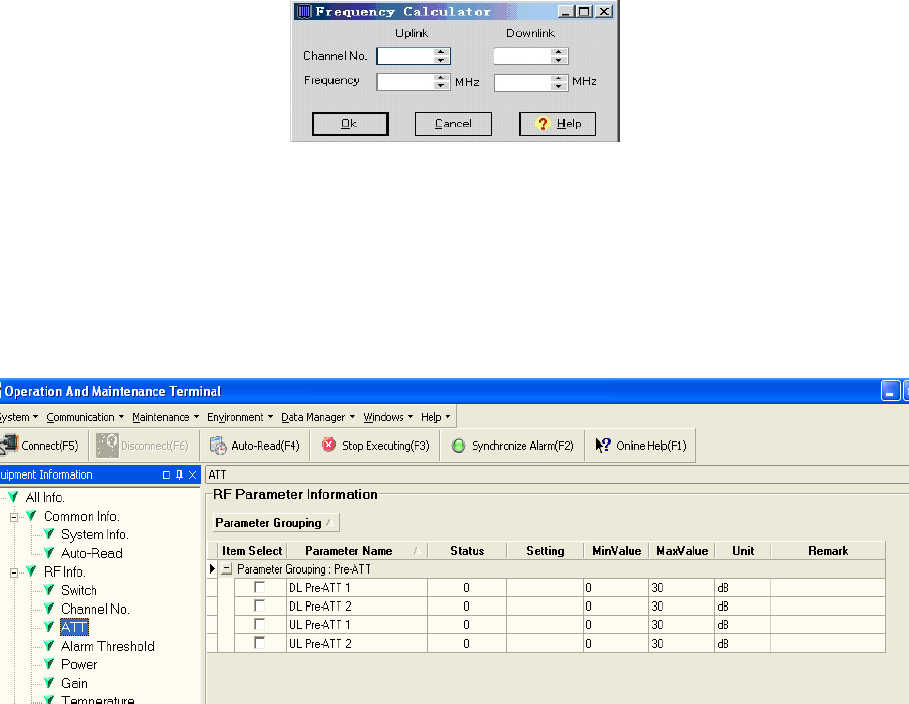
USER MANUAL FOR RD-8132
RD-8132 QI Copyright - refer to title page Page 17
ENU Status : 1-0-0
Config:
Enter the required value in setting columns and click [Config] button to finish the configuration operation.
There are two methods to insert the channel number:
z Insert the desired channel number (within the setting range) into the [Setting] column directly
z Right click the [Setting] column, the [Frequency Calculator] dialogue window seen as below will pop-
up, insert the desired channel number. Then the corresponding frequency will turn up automatically.
This function makes it easier for user to configure.
Figure 15: Frequency Calculator
3.3.3 ATT
ATT adjustment includes UL/DL ATT adjustment. The purpose of adjusting the ATT is to adjust system
gain.
DL/UL ATT 1/2 setting range: 0~30dB
Figure 16: ATT
Config:
Select the required value in setting columns of RF information window for ATT, and press [Enter] or
[Config] button to finish the configuration operation.
3.3.4 ALARM THRESHOLD
Alarm Threshold includes Power threshold, Temperature threshold and VSWR threshold.
Users can set alarm threshold according to the specific situation. If the measured value is lower than the
threshold lower limit or more than the threshold upper limit, the appropriate alarm will be generated.

USER MANUAL FOR RD-8132
RD-8132 QI Copyright - refer to title page Page 18
ENU Status : 1-0-0
Figure 17: Alarm Threshold
Config:
Enter the required value in setting columns of RF information window for Alarm threshold, and press
[Enter] or [Config] button to finish the configuration operation.
Notice: The input value must be in the range of power threshold. The DL VSWR threshold setting range is
available for only three values: 1.5, 2.0 and 2.5.
3.3.5 ALARM INFORMATION
Alarm information operation is to select alarm parameters for monitoring. Alarm parameters include Master
Alarm, Channel Alarm and External Alarm.
Click any tree node in [Alarm Info] group, [Alarm Parameter Information] window will appear in the right
side. The picture below shows the master alarm information.
Alarm Threshold Setting Range Initial Setting
DL Output Power Low Threshold 14~45dBm 14dBm
DL Input Power Overload Threshold -70~-49dBm -49dBm
DL Input Power Low Threshold -70~-49dBm -49dBm
PA Over-Temperature Threshold -40~125 oC 80 oC
DL VSWR Threshold 1.5, 2.0, 2.5 2.0
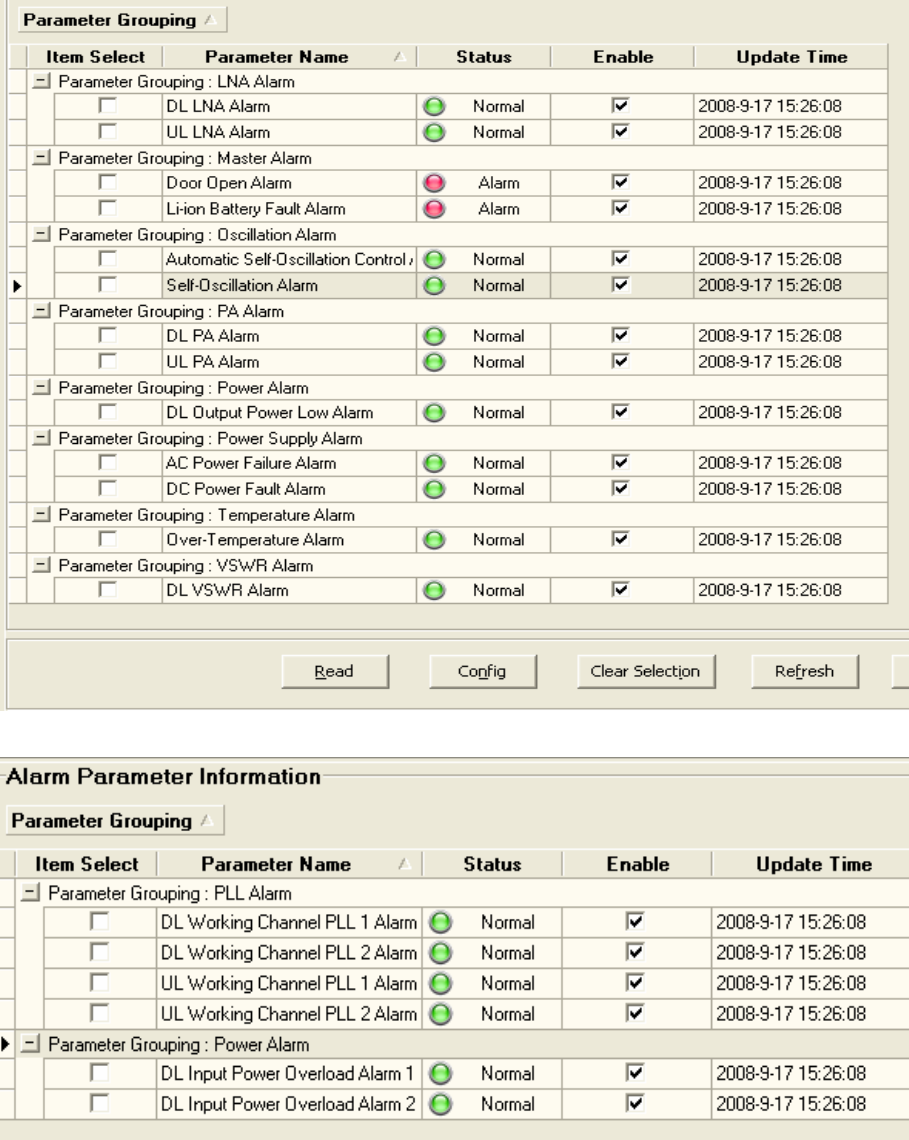
USER MANUAL FOR RD-8132
RD-8132 QI Copyright - refer to title page Page 19
ENU Status : 1-0-0
Figure 18: Master Alarm
Figure 19: Channel Alarm

USER MANUAL FOR RD-8132
RD-8132 QI Copyright - refer to title page Page 20
ENU Status : 1-0-0
Figure 20: External Alarm
Config:
Tick the check box of [Item select] and [Enable] of the desired parameters and click [config] button to finish
configuration operation.
Notice: [Enable] box is to enable the alarm monitoring for system. Only if users enable the alarm by
ticking the [Enable] box, the alarms can be monitored by the OMT/OMC.
On the MCU, if any alarm is generated and this alarm is also enabled in [Enable] box, LED H2 turns RED;
while it is OFF when normal working. On the OMT/OMC window, [Alarm Status] indicator keeps GREEN if
no alarm and turns RED if an alarm is generated.
Please notice that if the desired alarm is not enabled in [Enable] box, even if this alarm is
generated, it keeps in GREEN in the OMT/OMC interface and LED H2 on MCU keeps OFF as well.
3.4 PROPERTIES INFO.
3.4.1 EQUIPMENT ID
Equipment ID is to be configured after local commission has been completed, which includes Site ID, and
Site Sub ID.
Figure 21: Equipment ID
See the table below for configuration details of each parameter.
Item Description
Site ID Site ID is the unique equipment identification. It is a hexadecimal string of eight
characters in the range of [00000000~FFFFFFFF]. e.g. 00000000
Site Sub ID Site Sub ID is used for Master-Slave System. It is the unique identification of each
Master/ Slave Unit and is a hexadecimal string of two characters in the range of
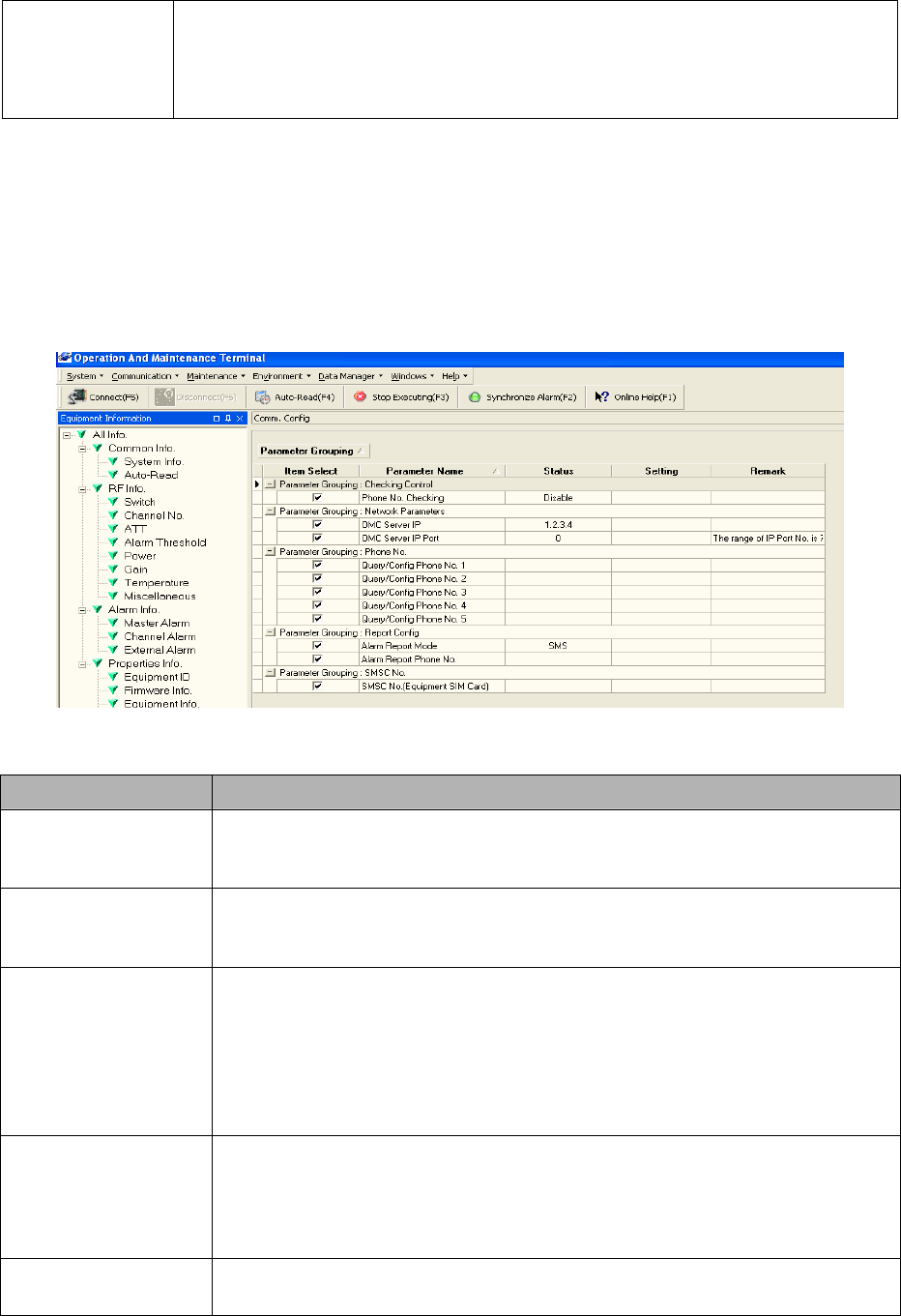
USER MANUAL FOR RD-8132
RD-8132 QI Copyright - refer to title page Page 21
ENU Status : 1-0-0
[00~FF].
For the system located with single equipment, the Site Sub ID should be FF.
For Master-Slave system, the Site Sub ID for Master Unit is 00, and the Site Sub
ID for each Slave Unit is represented in the range of [01~FE] in ascending order.
e.g. Master Site ID: 00, Slave Site ID: 01
3.4.2 COMM. CONFIG
If the equipment is to be monitored by OMC software over wireless GSM / CDMA network, users must
finish the [Comm. Config.] in the next step.
The Comm. Config information requires to be manually entered by users after successful connection to the
equipment.
Figure 22: Com. Config.
See the table below for configuration details of each parameter.
Item Description
Checking Control Select “Enable” or “Disable” from the drop down menu as shown to enable or
disable the Phone Number Authentication feature. Refer to [Phone No.] in
details.
OMC Server IP Based on the current network conditions, users can enter the IP address
information of the equipment, which is connected to the OMT/OMC via
Ethernet. This connection via Ethernet is not available at this stage.
Phone No. This is designed for authentication purpose when remote connection via
modem is required. It is the phone number to dial the equipment. Only the
phone number pre-defined in this field, will it be allowed to dial the equipment.
It is required to manually enter the phone number. Up to 5 phone numbers
are allowed. The use of phone number authentication can avoid unauthorized
use of the OMT. In addition, it can prevent the equipment receiving piles of
spam short messages, thus help the operator greatly reduce the cost.
Report Config The Report No. is the SIM card number of the modem built into the OMC
Server computer.The equipment will send alarm SMS to this number.
If remote communication is needed via modem, users have to enable SMS
mode and set the report phone No. by entering the SIM card number of the
equipment built-in modem.
SMSC No. It specifies the SMS center. Users have to set the service No. of SMSC for
the first installation, so that the alarms can be sent to OMC.
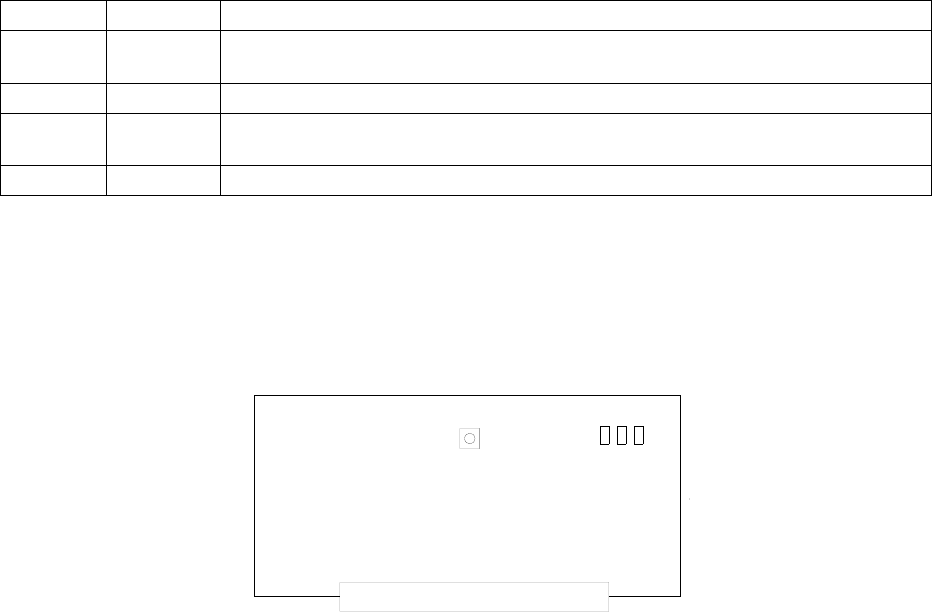
USER MANUAL FOR RD-8132
RD-8132 QI Copyright - refer to title page Page 22
ENU Status : 1-0-0
4 COMMISSIONING
4.1 PRE-COMMISSIONING TASKS
After equipment installation, perform the following steps before equipment powering and commissioning:
z Check the expected voltage, current and power levels do not violate any ratings.
z Visually inspect the power connection within the equipment. Ensure that the power cable is correctly
and securely connected, including grounding wire, RF cable and other cables.
z Check grounding connection and verify that the ground resistance is less than 5Ω.
z Test the antenna system and ensure the echo loss within working frequency is less than -14dB
(VSWR<1.5).
4.2 MCU LED INDICATOR AND RESET BUTTON
Diagnostic LEDs and a reset button are located on the MCU; each indicates the status of a particular
function:
Identifier Colour Indication
H1 Green MCU operation. Flashes at a rate of 1 flash/sec. Any other flashing rate
indicates MCU is faulty, and has to be replaced.
H2 Red Alarm LED. When ON, it indicates alarm condition.
H3 Red Wireless modem status. During normal operation, it is OFF. When ON, it
indicates faulty wireless modem and no communication will take place.
Reset N/A Reset button. Press the reset button to restart the system.
MCU Initialization Procedure
All three diagnostic LEDs of each MCU will flash simultaneously for three times when power is initially
supplied to the equipment. Then H1 will keep flashing at the rate of 1 flash/second. H2 will be ON when
any alarm occurs. After successful initialization of the wireless modem, H3 will be ON for about two
minutes and then turn off; otherwise, it will remain ON to indicate a problem.
Connect to Distribution Board
H2 H3H1
Push
Button
Figure 23: MCU

USER MANUAL FOR RD-8132
RD-8132 QI Copyright - refer to title page Page 23
ENU Status : 1-0-0
4.3 COMMISSIONING PROCEDURE
System commissioning can commence after the monitoring system has completed self initialization. The
commissioning procedure is as follows:
On- line & Inquiry Status
External Alarm
Yes
Enable External Alarm and Configure
Voltage applied to EXT Alarm
Set Channel NO.
Adjust Downlink ATT and Measure
Downlink Output Power
Signal Input
Exit from OMT
Remote Connection to OMC
Yes
Configure [Equipment ID]
Comm. Comfig
Select Monitoring Parameters
No
No
Test-Call
Double Check No Interference to BTS and
Antenna Isolation Meets Requirements

USER MANUAL FOR RD-8132
RD-8132 QI Copyright - refer to title page Page 24
ENU Status : 1-0-0
Commissioning Tasks Observation
1. On-line and Inquiry status
z Activate the OMT Main window. The system Initialization will
completed in about 2 minutes.
z Click “Connect” button to enquire the repeater’s status. Proceed if
there is no alarm; else check the failure and attend to the alarm.
2. Set Channel No.
z Keep RF switch ON and set the channel number of the repeater’s
operating frequency.
3. Adjust Downlink Output
Power and align donor
antenna
z Observe DL input power from measured value. Align the direction of
donor antenna until the DL input power reading is maximized.
z Note: To ensure that the measured DL input power is accurate, one
should set the DL ATT to “0” before performing the check.
4. Configure [Equipment ID] z Go to [Properties Info] and set [Equipment ID].
5. Comm. Config
z Enable the power supply by selecting “On” in [RF] -> [Switch]; go to
[Properties Info.] -> [Comm. Config.] and set OMC Phones No. , the
service No. of SMSC, Report Mode.
6. Select Monitoring
Parameters
z Select the equipment controlled and monitored parameters.
z If the external devices are connected to the equipment for
management, please enable in the [External Alarm Info.] Interface.
7. Test coverage area field
intensity and adjust
service antenna.
z Use test-handset to verify field intensity within the coverage area. If
needed, realign the service antenna to achieve the desired
coverage.
z Note: If during operation, the equipment gain could not be set to
maximum or the output power is not high enough due to insufficient
donor and service antennas isolation, then the antennas’ position
should be changed to increase isolation. If the output power is too
high and ALC is activated, then adjust the DL ATT to achieve
optimal DL Gain.
8. Verify UL gain and ensure
test call produces good
voice quality and there is
no interfering BTS
z Adjust UL gain and perform test calls. Typically, the UL gain is set
around 5dB less than DL gain. Perform test calls in the coverage
area while adjusting UL gain if required.
z Note: If the repeater is near the BTS and the test call performance
is poor, this may be due to UL noise interference to the BTS. Users
can calculate and determine if the repeater UL noise will interfere
with the BTS.
z Verify again that there is no unacceptable interference to BTS.
End of section

USER MANUAL FOR RD-8132
RD-8132 QI Copyright - refer to title page Page 25
ENU Status : 1-0-0
5 TROUBLESHOOTING
Following installation and commissioning, troubleshooting tasks to handle alarms may be required. Here
below is the alarm list of the equipment and diagnosis.
Alarm Diagnosis
AC Power Failure Alarm z Check AC power cable and verify AC mains supply is normal.
During power failed alarm, DC power supply has no output.
DC Power Fault Alarm z Check if DC output power is overload or short-circuited, if not, it
would be the fault of PSU.
Li-ion Battery Fault Alarm
z Check if the Li-ion Battery connection is correct or any damage of
the battery;
z Replace the fault Li-ion Battery if it couldn't be energized.
UL/DL LNA Alarm
UL/DL PA Alarm
UL/DL PLL Alarm
z Check power and signal connections of respective modules;
z If the power and signal wire connections are OK, then the
respective modules may be faulty;
z Replace the fault modules and return for repair.
DL Output Power Low Alarm
z Reset the output power low threshold;
z Reset the ATT value to increase the Gain;
z Check if Channel No. setting is correct;
z Check the cable connections;
z If alarm can not be cleared, check the equipment.
DL Input Power Overload Alarm
z Eliminate alarm by correct setting of the input power overload
threshold;
z Check if the intensity of signal source is large enough;
z If alarm can not be cleared, check the equipment.
Chassis Over- temperature
Alarm
z Eliminate alarm by setting of temperature threshold;
z If alarm can not be cleared, apply climatic protection to the
equipment.
DL VSWR Alarm z Check MT antenna system if there is downlink VSWR alarm.
Self-oscillation Alarm
z Check whether the Isolation between donor antenna and mobile
antenna is large enough;
z Adjustment to RX/TX antennas can eliminate self-excited
oscillation and verify the (I) could be 10dB larger than Gmax.
Door Open Alarm z Check whether the enclosure door is closed.
External Alarm 1~4 z Check if either of the external devices connected to the equipment
is faulty.
Table 1: Alarm List and Diagnosis
End of section
USER MANUAL FOR RD-8132
RD-8132 QI Copyright - refer to title page Page 26
ENU Status : 1-0-0
6 APPENDICES
6.1 APPENDIX A: SERVICE POLICY AND RETURN OF EQUIPMENT
The repair of individual units and modules of this equipment is not considered practicable without factory
facilities. It is, therefore, the policy of Comba whereby faulty units or modules are returned to the local
agent for repair. To enable an efficient, prompt after sales service to be provided for the diagnosis, repair
and return of any faulty equipment, please comply with the following requirements.
Items to be sent for repair should be packaged so as to provide both electrostatic and physical protection
and a Repair Material Authorization (RMA) should be completed giving the required information. A sample
RMA form is provided in Appendix.
This request must be included with the item for repair, items for repair should be sent to the nearest
Comba office:
COMBA TELECOM LTD.
Hong Kong Office
Address: 611 East Wing, No. 8 Science Park West Avenue, Hong Kong Science Park, Tai Po, Hong Kong.
Tel: +852 2636 6861 Fax: +852 2637 0966
Singapore Office
Address: No. 1 Kaki Bukit View, #02-10 Techview, Singapore 415941
Tel: + 65 6345 4908 Fax: + 65 6345 1186
Thailand Office
Address: 3rd Floor, T. Shinawatra Building, 94 Sukhumvit Soi 23, Sukhumvit Road, Klongtoeynua,
Wattana, Bangkok 10110
Tel: +66 2664 3440 Fax: +66 2664 3442
India Office
Address: Suite No. 2, E-172, TSH House, Greater Kailash – I, New Delhi – 110 048, India
Tel: + 91 11 4173 9997 / 8 Fax: + 91 11 4173 9996
Sweden Office
Address: Gustavslundsvagen 147, S- 167 51 Bromma, Stockholm, Sweden
Tel: +46 8 25 38 70 Fax: +46 8 25 38 71
Brazil Office
Address: Avenida Engenheiro Luiz Carlos Berrini 1297, cj 122, 04571-090 Brooklin Novo, São Paulo,
Brazil
Tel: +55 11 55050549 Fax: +55 11 55050549 ext 7
Dubai Office
Address: P.O. Box 450583, DUBAI, U.A.E.
Tel: +971 0 4 433 5320 Fax: +971 0 4 422 6774
US Office
Address: Comba Telecom Inc. 2390 Bering Drive, San Jose, CA 95131, USA
Tel: +1 408 526 0180 Fax: +1 408 526 0181
China Office
Address: No.10, Shenzhou Road, Guangzhou Science City, Guangzhou, China
Tel: + 86 20 2839 0000 Fax: + 86 20 2839 0136
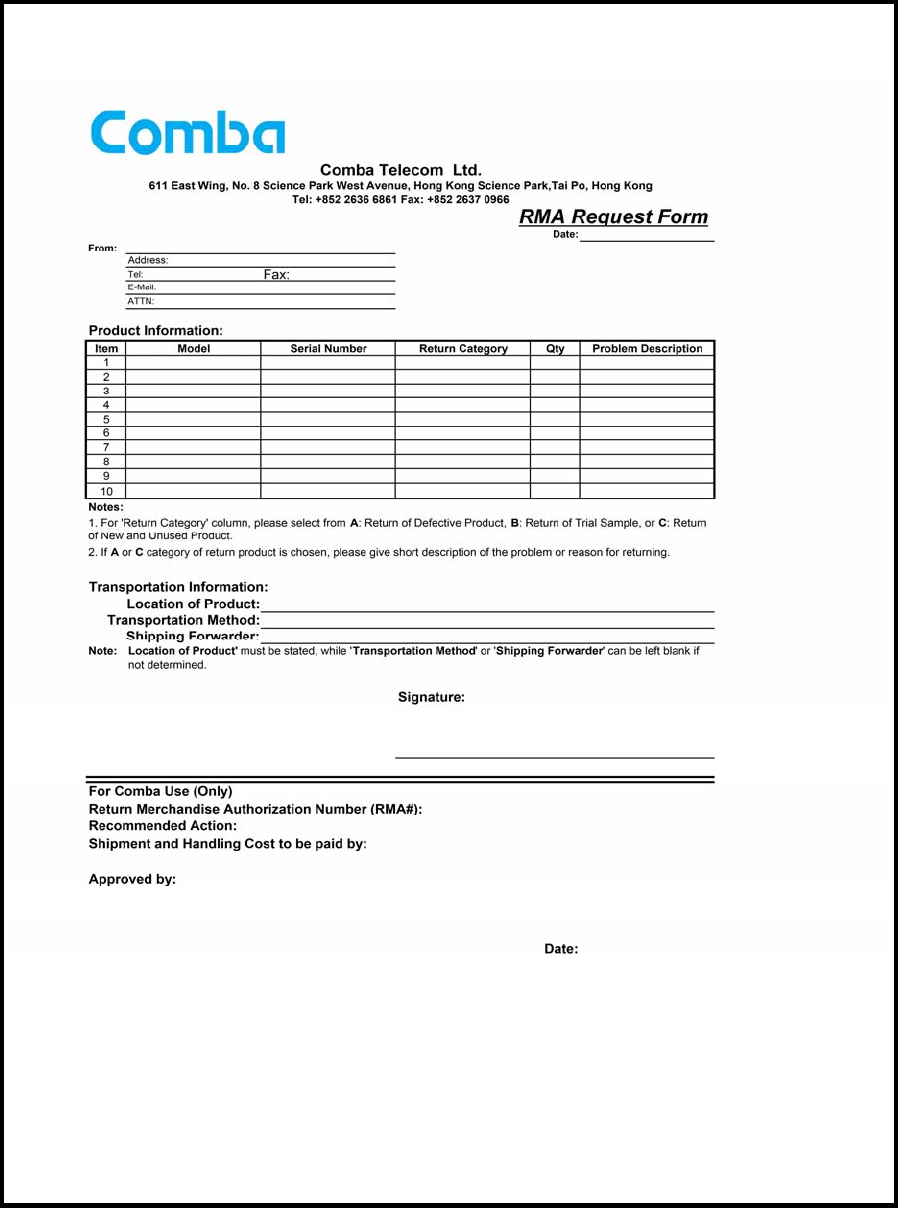
USER MANUAL FOR RD-8132
RD-8132 QI Copyright - refer to title page Page 27
ENU Status : 1-0-0
6.2 APPENDIX B: RMA (RETURN MATERIAL AUTHORIZATION) FORM
End of section
End of Document